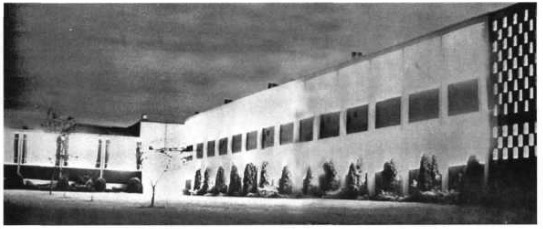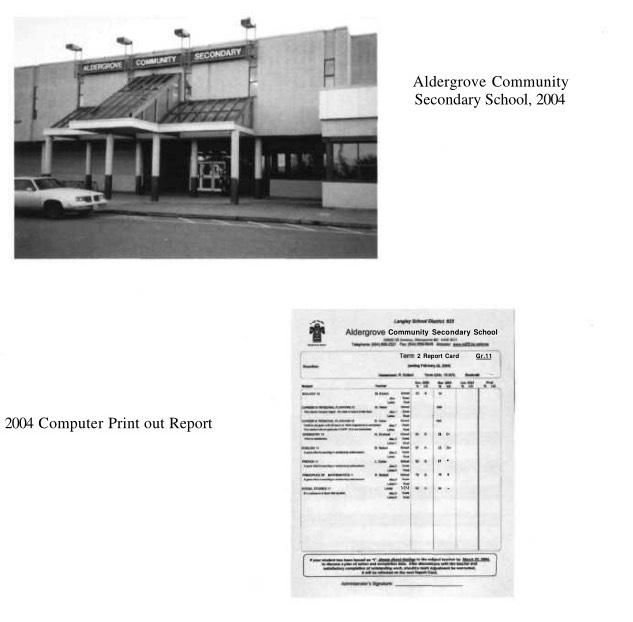History
By the late 1940s, the new Langley High School was filled and classes were on shift. It was proposed in 1953 to build a new high school with a catchment area east of the Langley Hospital to Matsqui and from the U.S. border to the Fraser River, a large sparsely-settled area. The site on Boundy Road (26850 – 29 Avenue) was chosen, but two referenda were defeated by the voters in 1954 and another in 1955. Finally, in 1956 a building program costing $1,115,500 was approved, and in 1957 a contract was let.
Starting in September, 1957, a “two schools” shift was in operation at Langley High School, with Langley in the morning and Aldergrove in the afternoon. Finally, in May, 1958, more than 520 students and 24 teachers moved into Aldergrove High School after four years of shifts. The official opening ceremony for the new Aldergrove Junior-Senior High School was on May 8,1958.
”One Hallowe'en while on hall duty, I apprehended a couple of students misbehaving. Detentions were issued. Around eight o'clock I glanced out of the front room window and noticed a couple of shadowy figures standing beside our car. I dashed out, but it was too late. Four flat tires! The next day at lunch hour I spoke to the boys, and it didn't take long to realize I had the culprits. As the discussion continued, they agreed they would pump up the tires. I phoned my wife, and when the boys arrived, she was waiting for them with a hand pump. When they finished, she thanked them and gave them their Hallowe'en treat. If there is a moral to this story, it is don't give detentions on Hallowe'en day.
Dick Chell
The first principal was Donald Hanson, with Roger C Winter as vice principal. The first grad class in 1958 had 35 students with the first valedictory address by Steve Nelson.
The first full year at Aldergrove Junior/Senior High School had students from grades 7 -12. Graduates wishing to take grade 13 went to Langley Junior/Senior High School.
The original school was built of concrete columns and beams, with block work, wood frame, and an exterior finish of stucco. Windows were wood and aluminum. Three sewer connections go from the school to 29 Avenue. The school is located on 17 acres (6.85 Ha). There is a galvanized chain link four foot high fence around the running track, on the east side, and along 29 Avenue. There is a 400 m rock dust track and one oval irrigated grass field within the track.
One of the unique features of the school was the boarding of native students from the Nass and Skeena areas. Most of these students came from Bella Bella and Bella Coola (where there was no high school) and stayed with local families. The school motto, logo, and house teams were adapted from various native tribes in BC Ellen Neel, daughter of Mungo Martin, carved a beautiful totem pole for the school. The school’s motto is “Hi All Yu Wen” which in Salish means “Second to None.” The school’s logo is a totem pole, and the original intramural house names were Haida, Nootka, Salish, and Tsimshian. The school teams are known as “The Totems.”
Extracurricular activities were encouraged at the school, including student council, parent-teacher organizations, annual musical productions and plays, clubs, dances, sports, etc. Some of the early productions put on at the school included “Only an Orphan Girl,” “Our Town, “Balbriggan Bay,” “Annie Get Your Gun,” “The Wizard of Oz,” “Babes in Toyland,” “South Pacific,” “Tulip Time,”” Alderama,” and many Christmas concerts. These productions were directed by staff, while students were heavily involved in playing the parts, production, and technical work.
”In the 1960s when I was coaching a grass hockey game, the new PE teacher, Louise Hemingway, came out to watch the proceedings and learn what grass hockey was all about. We were having a rather rough game that day, and Mrs. Hemingway was dismayed that during the course of the game, three girls had to be driven to the hospital. Parents took the first two, and later Mrs. Hemingway took the third victim. None of the girls was seriously injured, but I'm sure that was the roughest game I ever coached. Needless to say, Mrs. Hemingway never volunteered to coach or even watch grass hockey at Aldergrove Secondary again.
Maureen Pepin
During Norm Sherritt’s years at the school (1968-79), school carnivals were a major undertaking every second year. Every home room division was responsible for an activity, including dunk tanks, cake walks, booths of chance, pizza huts, Japanese tea gardens, dinners for hundreds, etc. It was an excellent way of promoting school spirit and a sense of community, as well as raising money for extra curricular activities.
Some of the clubs at the school included the Interschool Christian Fellowship, Reception and Catering, Dancing, Journalism, Orchestra, Stamp, Band, Choir, Outdoor, International, Projectionist, HiY and Y-Teens, Tumbling, Gymnastics, Yearbook, Grovette Club (cheerleaders), Library Assistants, Public Speaking, Debating, Photography, Wood Finishing, Art Service, Drama, Sky Diving, Future Farmers, Future Teachers, and Ping Pong
Homecomings have been held at the school in 1968,1978,1988 (30 years), and 1998 (40 years)
School spirit was generated when student/teacher activities were introduced. The Staff Room Seatwarmers defeated the Cafeteria Commandos in 1958 and won the black horse collar trophy. The Blue Toilet Seat trophy was awarded annually to the winner of the staff/student volleyball game. The Fireman’s Axe trophy (football) and the Souffle and Ham and Eggs trophies (basketball) were for the winners of games between Aldergrove Secondary and Langley Secondary.
After Don Hanson moved to Abbotsford in 1968, Norman Sherritt became principal. Principals since Mr. Sherritt’s retirement in 1979 are as follows: John Ruffelle, Kiyo Hamade, Mike Baker, Dan Peebles, Graham Leask, Charlie Etchell, and Charlie Fox. Vice principals following Roger Winter included Alex Goostrey, Gerry Kinnie, Maureen Pepin, Les Dukowski, Ray Melnyk, Peter Good, Peter Beckett, Charlie Etchell, Derek Robinson, Magdy Ghobriel, and Chris Atkinson.
The school office was renovated after the fire of 1970, and in 1976 renovations included a new office, a commerce/home economics addition, and a library. A music room addition, an up-to-date industrial education department (1979), a new science area, a small gym, and a cafeteria (1981) were also added. The gravel parking lot and Boundy Road (29) were paved in the 1980s.
In 1993 the entire school was rebuilt, with new office areas, new staff room and counselling areas, completely renovated science areas, a courtyard, a new gym, renovated classrooms, the removal of the commerce addition, a new facade; in fact, a new school. The bush area that surrounded the school now houses the Aldergrove library and Kinsmen Community Centre, groomed playgrounds, new housing, and Betty Gilbert Elementary to the south.
A Perinatal Program operated from 1986 to 2001, offering young mothers a chance to complete high school.
The teaching cafeteria has been operating successfully for many years, providing lunches at the school and breakfasts for a neighbouring elementary school.
”In 1969 mini-skirts were in style, but much hated by women teachers who had to bend over desks to help students. When pant suits were introduced, teachers were ecstatic. The only problem was that girls were not allowed to wear jeans or trousers to school, so how would teachers get away with wearing pant suits? Around the lunch table, the teachers plotted that in September, 1970, the most attractive female teacher on staff would arrive in a modest pant suit. She did. The roof did not fall in. Within the week, almost all the female teachers wore pant suits, and the "no jeans" rule was soon rescinded.
Leona French
The school has always had an active sports program. In rugby the team went on international tours in 1993 and 1997 (England and France), 2001 and 2005 (girls’ tour of Europe), and 2002 (Australia). The boys’ rugby team won Provincial A A championships in 1993 and 1997. The girls’ rugby team won the Provincial AAA championship in 2004. In basketball, Aldergrove teams won provincial championships in 1993 and 1994. For years the school had an active and successful gymnastics program coached by Louise Chesley, a former Olympian.
As part of their international focus, the school has a 1997 agreement signed with the Sapporo Nihon University School in Sapporo, Japan, and a 1997 agreement with Tyee High School in Seatac, Washington. The Global Education class built a children’s shelter in Nepal in 2000. Nearly 60 students from Asian countries attend the school on the International Program, which was started in 1992.
The school has a successful music program which annually presents a series of concerts. In 1997 it was awarded the best secondary school jazz music program. Tyler Summers was awarded the best secondary jazz musician in 1998. In 2003 the director, Marty Summers, was awarded the BC Secondary Music Educator of the Year award.
The school is now known as Aldergrove Community Secondary School. The present administration (2004) has Charlie Fox as principal, and Frank Roberto and Edna Schuerhaus as vice principals. The school population in 2004 is 1009 plus 39 International students. In 2004 there are 18 standard classrooms, 5 science rooms, 2 home economic labs, 4 shops, a full size gym and a mini gym (named in honour of Louise Chesley), a library, cafeteria, teaching kitchen, music room, rooms for special ed (Trainable Mentally Handicapped, Special Education, Learning Assistance), counselling area, office, greenhouse, 4 computer labs, 2 art rooms, a drama room, dramnasium, drafting room, and an electronics room.
(condensed from The Place Between, Vol. II, by L. Chesley)


